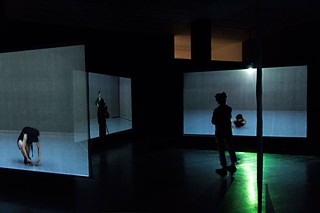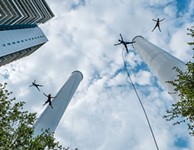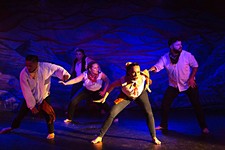A Continuity of Discontinuity
By Jonelle Seitz, Fri., March 21, 2014
In a darkened room, you enter a space semi-enclosed by four large screens arranged in a spiraling suggestion of a rhombus. The dance projected on them, Deborah Hay's No Time to Fly, seems to have crashed into the center of the room and fissioned into multiple realities.
No matter your viewpoint, you cannot take them all in, though your brain pleads to. You realize that the center, surrounded by the panels, is not necessarily the best place to stand. The projections are double-sided, each side showing a mirror image of the other, and all viewpoints are justified: inside or outside the rhombus, facing a screen head-on, viewing one on a slant with another slicing edgewise into your frame. Wandering freely or tracing figure eights around them, you might wish for a chair, so you can give up peripateticism in favor of a more passive experience. But there isn't one.
Nearly life-size onscreen, Hay's dancers – Ros Warby, Jeanine Durning, and Juliette Mapp – are riveting, their movements less often transitions than ends in themselves. When a screen goes black, the absence is numbing. Near the end of the videos' 13-minute loop, Durning falls heavily to the floor, minus a thump. Instead of the dance-sounds of breath, exertion, and friction, Hay's barely audible soundtracks emanate something like what Robert Frost called the "sound of sense" – what distinguishes conversation even when you can't make out the words – and the other human sounds of self-soothing, via song, and struggle.
Of course, Frost doesn't belong here, now, so you try to kick him out, but the association persists, because he and Hay have in common the pilgrimage toward an essential humanness. Through commissioning multiple responses to one meticulously open choreographic score, Hay seems to journey toward the choreography itself. In dance genres from ballet to bharata natyam, codified technique is a narrow route to an oasis. What if, Hay seems to ask, the choreographic score is also a route, perhaps one less narrow yet more direct?
Yet after fatigue causes you to seek refuge in the adjacent room, where comfortingly single-sided texts, drawings, and video circumscribe Hay's work, you return to the piece, only to find that though you're more familiar with the order of the movements, you feel less hold on it than before. Days later, as you write this, you make a note for next time: Try lying on the floor.









